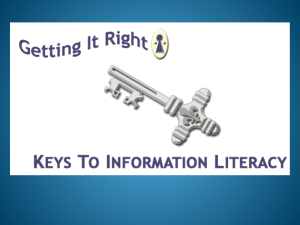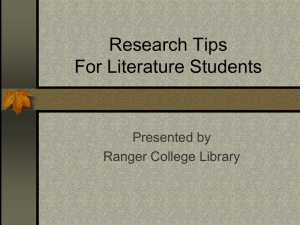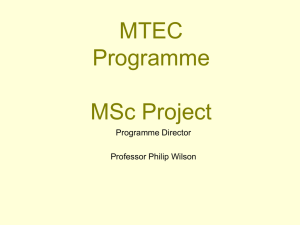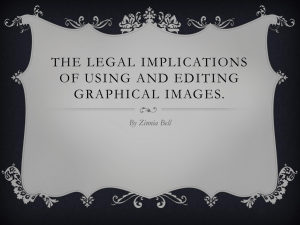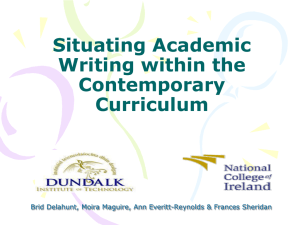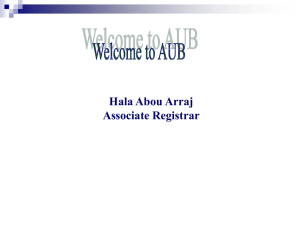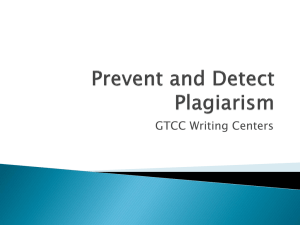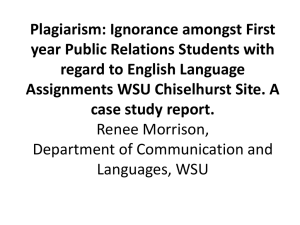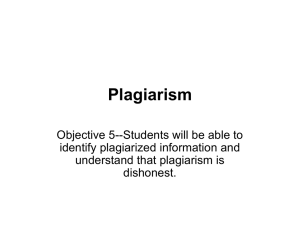infor literacy lecture 2011
advertisement
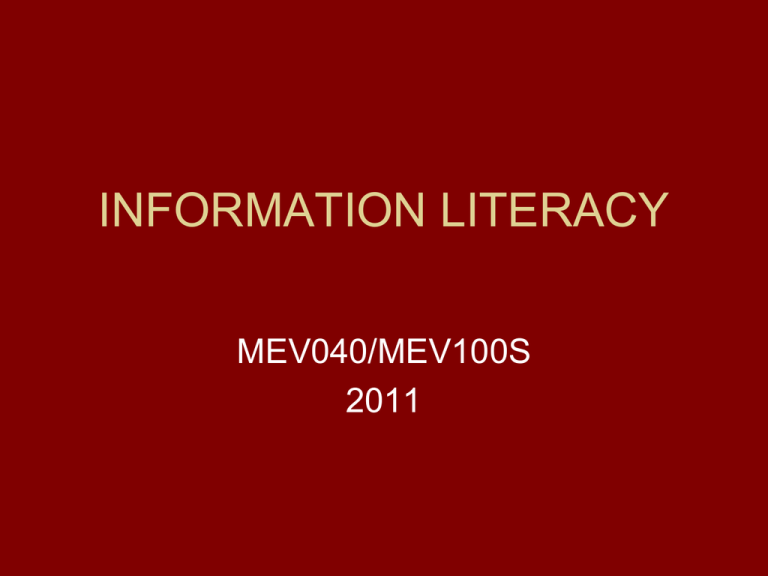
INFORMATION LITERACY MEV040/MEV100S 2011 DEFINITIONS “The ability to access, evaluate, organise, and use information from a variety of sources.” (Humes, n.d.) DEFINITIONS… “ Information literacy is knowing when and why you need information, where to find it, and how to evaluate, use and communicate it in an ethical manner.” (http://www.cilip.org.uk/professionalguidan ce/informationliteracy/definition/) DEFINITIONS… "To be information literate, a person must be able to recognize when information is needed and have the ability to locate, evaluate and use effectively the needed information" (American Library Association, 1989) An Information Literate person should be able to: 1. recognise the need for information 2. recognise that accurate and complete information is the basis for intelligent decision-making 3. identify potential sources of information 4. develop successful search strategies 5. access sources of information, including computer-based and other technologies An Information Literate person should be able to: 6. evaluate information 7. organise information 8. integrate new information into an existing body of knowledge 9. use information in critical thinking and problem solving Information Literacy Task 1 - 2011 “Increasingly, engineering practitioners and managers need to know how to respond to challenges of integrating environmentally conscious technologies, techniques, strategies, and objectives into their daily work” (Kutz, 2007). In no more than one typed page (about 500 words), excluding illustrations if you use any, discuss to what extent you believe this to be true and give some reasons why. Please use examples in your discussion, based on what you have researched. Questions to ask yourself What must I do? Where can I find the information I need? Which are the best possible sources? Which databases are the best choices? Which types of sources will best help me solve my information problem? Which sources do I already have? Do I need help to find the resources or to make sure I haven't overlooked any critical sources? Sources of information • • • • • • • Books Journals Magazines Newspapers People who are informed – experts The internet Etc. Finding information • http://www.cput.ac.za (go to library – see information literacy) • http:///www.dlist.org Plagiarism 1. 2. 3. 4. What is plagiarism? stealing and passing of ideas/words of another as your own. Using another’s work without giving credit to the source To commit literary/academic theft Presenting information from an existing source as your original work. (Merriam-Webster Online Dictionary) Plagiarism What students do: 1. submit another’s work, word-for-word as their own 2. Copy significant portions of text straight from on source without alteration 3. Try to disguise plagiarism by copying from different sources, changing sentences here and there… 4. Sources are not properly cited Plagiarism Reasons for Intentional plagiarism: 1. Searching but not researching 2. Thinking that someone else has said it better than you can 3. Passing – focus on end result 4. Going with the flow: “everyone else is doing it” 5. Poor planning How to avoid Plagiarism • Understand what you are reading – to enable you to write in your own words (paraphrase) • Reference your work (see CPUT guide) • Keep track of all sources/references used • Know the difference between common knowledge and the intellectual property of others COMMON PROBLEM AREAS 1.LANGUAGE USE – Tenses (is,was,were) – Concord (subject does not agree with the verb) – Spelling – Articles (the, a, an) incorrectly used and/omitted – Emotive words used – 1ST person speech COMMON PROBLEM AREAS 2. LACK OF PROOFREADING 3. PARAGRAPHS ARE NOT LOGICALLY LINKED 4. LACK OF ADEQUATE VOCABULARY 5. INCORRECT REFERENCING (WORDS AND ILLUSTRATIONS) 6. PLAGIARISM VS PARAPHRASING COMMON PROBLEM AREAS 7. Insufficient sources of information used and/consulted 8. Unfamiliar terms not explained/clarified 9. Final presentation unprofessional Written work • Should have a good beginning/introduction – Provide a context – State what the focus of the piece of writing is: • This essay focuses on… • This focus of this paper is… • In this thesis the …is presented… • Should be clear and understandable • There should be conceptual and logical links within and between paragraphs Written work cont… • Words should be used correctly and spelt correctly (use a dictionary) • Your in-text references should be accurate e.g. It is important for Environmental Engineering students to write well (Ziegler, 2011). Written work cont… • According to Ziegler (2011:12), “Students forget that their written work reflects the quality of their efforts”. • Use examples/evidence to support what you say • The conclusion should be linked to the rest of your writing and should cleverly summarise/reiterate main points Written work cont… • Bibliography should be: – accurate and reflect all references from text – In alphabetical order e.g. Omar, I. 2011. Environmental Engineering at CPUT. Essex: Smurf Publishing. Woods, R. and Felder, R. 2000. Chemical Reactions. Cape Town: Peacock. Ziegler, R. 2011. The Joys of Writing. Durban: Wishful Publishers. Questions to ask yourself • Am I proud of the work I have produced? • Is it effective? • Have I met the guidelines or followed the rubric for the project? • Am I sure I did not plagiarise from any of my sources? • Have I written for my intended audience? • Is this the best work I could have done?
